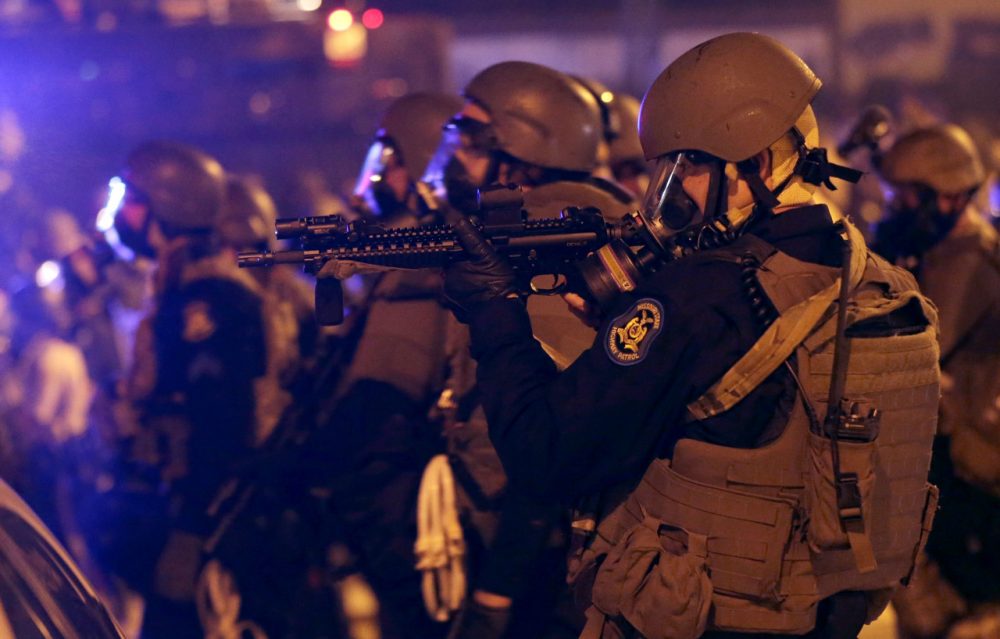Advertisement
Local Police With Tear Gas Launchers: Overkill? Or Wise Precaution?
Resume
When the National Guard got involved in the ongoing protests in Ferguson, Missouri, its arrival was intended to bring a stop to the violence that's been raging there for more than a week.
Instead, things have gotten worse. Tuesday morning, police said they came under heavy gunfire and made 31 arrests.
Because of that downward spiraling situation — soldiers on the ground, tear gas in the air — the debate over what many people call the militarization of domestic law enforcement is a topic of very hot discussion these days. Even President Obama has weighed in, insisting that clear lines are needed.
"There is a big difference between our military and our local law enforcement, and we don't want those lines blurred," the President said Monday. "That would be contrary to our traditions."
But it's a complex issue. Consider: if you were a police officer responding to a crowd throwing Molotov cocktails, would you want a car or an armored car? If your job was to go into a barricaded house to get an armed man, would you want body armor? Is this police militarization or just modernization?
WBUR's Sacha Pfeiffer explores the pros and cons of local police departments having military-grade weaponry.
Guest
William Brooks, chief of the Norwood Police Department, which tweets @ChiefBrooksNPD and @NorwoodPolice.
Jessie Rossman, staff attorney with the American Civil Liberties Union of Massachusetts, which tweets @ACLU_Mass.
Highlights
On describing changes to police departments in Massachusetts as "militarization":
William Brooks: "I suppose the term has a number of meanings on a number of different levels. I think, in some places, the police uniform has changed a little bit, with ball caps and pants tucked in boots and that sort of thing. And, you know, we don't do that in my department. We wear a very traditional police uniform. I guess, on second level, the use of...military surplus equipment, has raised some concerns. For the most part, what I've seen are assets that are defensive, not offensive. And I'm not familiar with the use of MRAPS [mine-resistant ambush-protected vehicles] by police departments. I've read recently that there's some of that."
On the difference between offensive and defensive weapons:
DW: "I've seen, as reported on television, the use of armored vehicles by the police. And I understand, I guess, what that represents to some people. They look at it and they're concerned by it and maybe they're frightened by it. But those vehicles are defensive. They don't launch anything. All they're used for is by the police to get closer to a scene, maybe to get to a hot zone where there's gunfire and to there safely. Ironically, I saw someone on television just the other night and the commentator was talking about militarization. They were showing some of these armored vehicles, but I saw on the news today that some of those same vehicles are being used to extricate protesters who have gotten injured, so they're defensive. Helmets worn by the police — there's been some concern about the appearance of the police in situations like this. And I'm not talking just Ferguson, but situations like this...Police have worn helmets back to the early 1900s. But even if you look at demonstrations in the '60s around the Vietnam War and the Civil Rights Era, the police who were put in those situations wore helmets to protect themselves. And although they might be, these days, military-grade or using military technology, it is defensive."
On the use of SWAT teams by local police departments:
Jessie Rossman: "Firstly, I want to thank the chief for coming on and speaking with us today. I think it's important for us to have this dialogue. I've heard a lot of what he's saying and we agree: we want our police officers to be safe in our community. We agree that that's important. But I think it's important to really crystallize what we're talking about here. The chief mentioned defensive strategies, and it's true that SWAT teams really were originally intended for dealing with situations like hostage situations, active shooters, etc. But the ACLU did a national review, and looking at over 800 SWAT deployments, only 7 percent of those deployments involve things like an armed hostage situation or an active shooter. Almost 80 percent of those deployments were dealing with having search warrants be served in houses, and that often led to breaking down people's doors with battering rams and exploding flashbang devices...It's actions like that that make people feel like their homes have become a battlefield and that the very police that are meant to serve and protect them are making them less safe. And when we talk about militarization, that's a lot of what we're focusing on. People not feeling safe in their own communities."
On local police department carrying military-grade weapons:
JR: "I think there is a danger that when you have a hammer everything looks like a nail. And it is very easy, when you have that capability, to all of a sudden start using it in situations where they're not necessary. It's possible for us to have a conversation today about limiting and having very public and clear directives informing police departments when they should use their SWAT teams, when it's actually necessary and how they're going to make that kind of information publicly available. But the problem is, that's not what we're seeing today. There are no standardized forms about informing police departments when they should use this militarized capability and as a result we end up in a situation where our homes have become a battlefield."
On training in anticipation of police needs:
DW: "As far as equipment and training, it's too late to get it when the event is underway. So I suppose that departments want to create a capability so in case they have an active shooter in a school or an active shooter at an indoor or outdoor environment, they want a way to get their officers in safely. Before these so-called BearCats were available, your police departments would grab a firetruck or try to get a garbage truck and try to walk behind it, that sort of thing. Now that the wars are winding down and the 1033 program [Department of Defense Excess Property] is making some of this stuff available, some departments are taking advantage. They can get it, in some cases, at no cost and can have it on hand in case an event occurs. So I think that's probably why departments have utilized it. Again, we don't have that on my department...The same issue comes up with firearms training. How much do you shoot? Maybe you shouldn't practice as much at the range because you don't have as many shootings. Well, it's too late. It's too late when the event occurs. So if you have the opportunity to protect your people with an armored vehicle or you have the opportunity to do firearms training, then you may take that opportunity."
More
Radio Boston: Tufts Professor: Ferguson Exposes Civil Rights Generational Divide
- "They were told that segregation was overcome. They were told that we were all existing in a bad dream of racial insecurity, and that their parents and grandparents fought and died and struggled so they could have more access. And when they open up their eyes every day they’re seeing it’s an all-black neighborhood that they grow up in, it’s run-down, the streets are segregated."
On Point: The Militarization Of America’s Local Police Forces
- "Issue after issue being lit up in flares and protests. Looming out of the clouds of teargas. And one of the first was this: in 2014 America, the police bring a stunningly military profile to the streets long before the National Guard shows up."
This article was originally published on August 19, 2014.
This segment aired on August 19, 2014.
